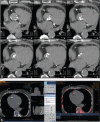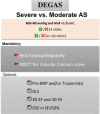Discordant Echocardiographic Grading in Low Gradient Aortic Stenosis (DEGAS Study) From the Italian Society of Echocardiography and Cardiovascular Imaging Research Network: Rationale and Study Design
- PMID: 33282641
- PMCID: PMC7706377
- DOI: 10.4103/jcecho.jcecho_68_20
Discordant Echocardiographic Grading in Low Gradient Aortic Stenosis (DEGAS Study) From the Italian Society of Echocardiography and Cardiovascular Imaging Research Network: Rationale and Study Design
Abstract
Background: Low-gradient aortic stenosis (LG-AS) is characterized by the combination of an aortic valve area compatible with severe stenosis and a low transvalvular mean gradient with low-flow state (i.e., indexed stroke volume <35 mL/m2) in the presence of reduced (classical low-flow AS) or preserved (paradoxical low-flow AS) ejection fraction. Furthermore, the occurrence of a normal-flow LG-AS is still advocated by many authors. Within this diagnostic complexity, the diagnosis of severe AS remains challenging.
Objective: The general objective of the Discordant Echocardiographic Grading in Low-gradient AS (DEGAS Study) study will be to assess the prevalence of true severe AS in this population and validate new parameters to improve the assessment and the clinical decision-making in patients with LG-AS.
Methods and analyses: The DEGAS Study of the Italian Society of Echocardiography and Cardiovascular Imaging is a prospective, multicenter, observational diagnostic study that will enroll consecutively adult patients with LG-AS over 2 years. AS severity will be ideally confirmed by a multimodality approach, but only the quantification of calcium score by multidetector computed tomography will be mandatory. The primary clinical outcome variable will be 12-month all-cause mortality. The secondary outcome variables will be (i) 30-day mortality (for patients treated by Surgical aortic valve replacement or TAVR); (ii) 12-month cardiovascular mortality; (iii) 12-month new major cardiovascular events such as myocardial infarction, stroke, vascular complications, and rehospitalization for heart failure; and (iv) composite endpoint of cardiovascular mortality and hospitalization for heart failure. Data collection will take place through a web platform (REDCap), absolutely secure based on current standards concerning the ethical requirements and data integrity.
Keywords: Aortic valve calcium score; aortic valve stenosis; diagnosis; dobutamine stress echocardiography; echocardiography.
Copyright: © 2020 Journal of Cardiovascular Echography.
Conflict of interest statement
There are no conflicts of interest.
Figures




Similar articles
-
Outcome of Flow-Gradient Patterns of Aortic Stenosis After Aortic Valve Replacement: An Analysis of the PARTNER 2 Trial and Registry.Circ Cardiovasc Interv. 2020 Jul;13(7):e008792. doi: 10.1161/CIRCINTERVENTIONS.119.008792. Epub 2020 Jul 17. Circ Cardiovasc Interv. 2020. PMID: 32674676 Clinical Trial.
-
Transcatheter Aortic Valve Implantation in Patients With Paradoxical Low-Flow, Low-Gradient Aortic Stenosis.Am J Cardiol. 2018 Aug 15;122(4):625-632. doi: 10.1016/j.amjcard.2018.04.044. Epub 2018 May 17. Am J Cardiol. 2018. PMID: 30064863
-
The complex nature of discordant severe calcified aortic valve disease grading: new insights from combined Doppler echocardiographic and computed tomographic study.J Am Coll Cardiol. 2013 Dec 17;62(24):2329-38. doi: 10.1016/j.jacc.2013.08.1621. Epub 2013 Sep 24. J Am Coll Cardiol. 2013. PMID: 24076528
-
What Is New in Low Gradient Aortic Stenosis: Surgery, TAVR, or Medical Therapy?Curr Cardiol Rep. 2020 Jul 9;22(9):78. doi: 10.1007/s11886-020-01341-x. Curr Cardiol Rep. 2020. PMID: 32648081 Review.
-
Imaging Strategies for Evaluating Low-Flow, Low-Gradient Aortic Stenosis with Reduced and Preserved Left Ventricular Ejection Fraction.Curr Cardiol Rep. 2019 Jul 27;21(9):94. doi: 10.1007/s11886-019-1186-9. Curr Cardiol Rep. 2019. PMID: 31352636 Review.
Cited by
-
Clinical, echocardiographic and prognostic outcomes of patients with concordant and discordant high-gradient aortic stenosis in an Asian cohort.Int J Cardiovasc Imaging. 2022 Jun;38(6):1351-1360. doi: 10.1007/s10554-022-02524-z. Epub 2022 Feb 19. Int J Cardiovasc Imaging. 2022. PMID: 35182257
-
Integrating Echocardiographic Findings to Improve Diagnostic and Prognostic Assessments in Moderate Aortic Valve Stenosis: A Comprehensive Review.J Tehran Heart Cent. 2024 Jul;19(3):153-161. J Tehran Heart Cent. 2024. PMID: 40271169 Free PMC article. Review.
-
ABCDEG Stress Echocardiography in Aortic Stenosis.Diagnostics (Basel). 2023 May 12;13(10):1727. doi: 10.3390/diagnostics13101727. Diagnostics (Basel). 2023. PMID: 37238211 Free PMC article. Review.
References
-
- Dulgheru R, Pibarot P, Sengupta PP, Piérard LA, Rosenhek R, Magne J, et al. Multimodality imaging strategies for the assessment of aortic stenosis: Viewpoint of the heart valve clinic international database (HAVEC) Group. Circ Cardiovasc Imaging. 2016;9:e004352. - PubMed
-
- Delgado V, Clavel MA, Hahn RT, Gillam L, Bax J, Sengupta PP, et al. How do we reconcile echocardiography, computed tomography, and hybrid imaging in assessing discordant grading of aortic stenosis severity? JACC Cardiovasc Imaging. 2019;12:267–82. - PubMed
-
- Ternacle J, Clavel MA. Assessment of Aortic Stenosis Severity: A Multimodality Approach. Cardiol Clin. 2020;38:13–22. - PubMed
-
- Guzzetti E, Pibarot P, Clavel MA. Normal-flow low-gradient severe aortic stenosis is a frequent and real entity. Eur Heart J Cardiovasc Imaging. 2019;20:1102–4. - PubMed
